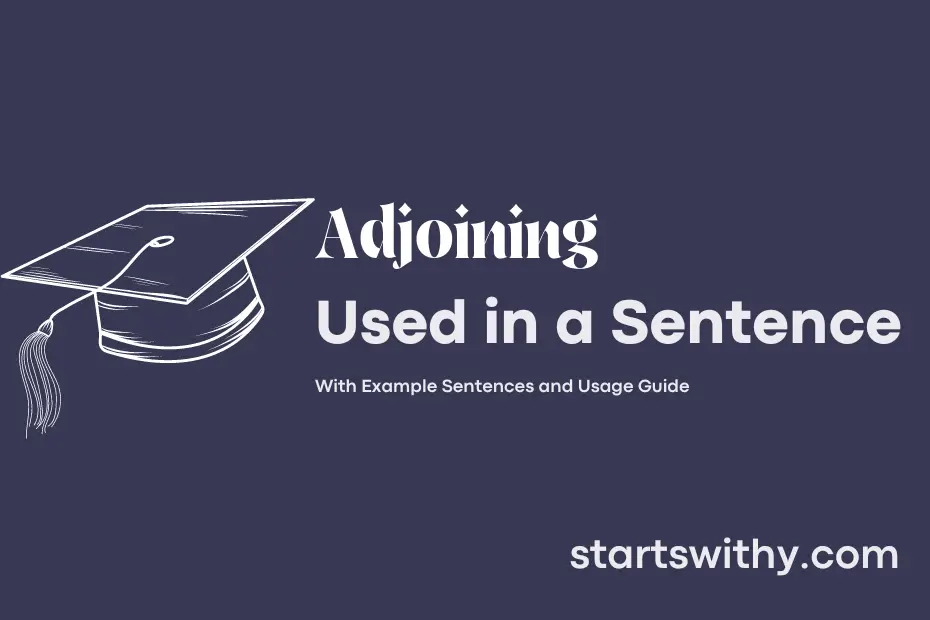Have you ever come across the term “adjoining” in a text and wondered what it meant? Simply put, when two things are said to be adjoining, they are connected or next to each other in some way. This word is commonly used to describe things that are touching or in close proximity to each other.
In various contexts, the term “adjoining” is used to highlight the relationship or physical proximity between two objects, spaces, or areas. Whether referring to adjoining rooms in a house or adjoining countries on a map, this word helps convey the idea of things that are adjacent or connected in some manner.
7 Examples Of Adjoining Used In a Sentence For Kids
- The adjoining room is where we store our toys.
- Let’s explore the adjoining garden after class.
- Our classroom has an adjoining play area.
- I can see my friend’s house from our adjoining balcony.
- The adjoining park is filled with colorful flowers.
- We can have a picnic in the adjoining field.
- The adjoining library has lots of interesting books.
14 Sentences with Adjoining Examples
- The library adjoining the main building is a great place to study.
- The canteen adjoining the college campus serves delicious food.
- The sports complex adjoining the hostel is where we play cricket.
- The girls’ hostel is adjoining the boys’ hostel on the same street.
- The classroom adjoining the laboratory is where we have physics practicals.
- The bus stop adjoining the college is always crowded with students.
- The park adjoining the college is a popular spot for students to relax.
- The shopping complex adjoining the college campus is perfect for buying stationery.
- The ATM adjoining the college is convenient for withdrawing money.
- The music room adjoining the auditorium is where we have band practice.
- The coffee shop adjoining the college gate is a favorite hangout spot.
- The swimming pool adjoining the college is where we unwind after exams.
- The seminar hall adjoining the library is where guest lectures are conducted.
- The parking lot adjoining the college is always full during events.
How To Use Adjoining in Sentences?
Adjoining
To use the word “adjoining” in a sentence, you need to understand its meaning. Adjoining refers to things that are next to or in contact with each other, usually sharing a common boundary or line. Here is a simple guide on how to incorporate it into your sentences:
-
Identify the two separate things or places that are connected or next to each other. For example, “The two adjoining rooms were connected by a shared bathroom.”
-
Place the word “adjoining” before the noun it is describing to clearly indicate their proximity or connection. For instance, “The kitchen’s adjoining dining room made it easy to serve meals.”
-
Make sure to use “adjoining” in a way that clearly shows the relationship between the two items. You can use it to describe physical spaces, concepts, or abstract ideas that are contiguous or connected.
By following these simple steps, you can easily incorporate the word “adjoining” into your sentences to express the idea of things being next to each other or sharing a common border. Practice using this word in different contexts to become more comfortable with using it effectively in your communication.
Conclusion
In writing, sentences with adjoining elements are used to create cohesive connections between ideas or clauses. They serve to link different thoughts seamlessly, enhancing the overall flow and coherence of the text. By employing sentences with adjoining phrases, writers can clarify relationships, provide additional context, or transition smoothly from one point to another.
Whether it’s through conjunctions, transitional words, or punctuation marks, sentences with adjoining components play a crucial role in guiding readers through a logical progression of information. Recognizing and utilizing these structures effectively can greatly improve the clarity and readability of any piece of writing, making it easier for the audience to follow the writer’s train of thought.



